Abstract
The importance of physical training in the game of tennis is already well known. Specialists in the field of sports have done a lot of research and studies on strength programs used in sports training, especially in specific sports: weightlifting, bodybuilding, but for the specific tennis are still few. As a basic component in sports training, physical training has the following objectives: increasing the physiological potential of the athlete and developing biomotor qualities at the highest level to achieve high performance in sports competitions. For the training of the athletes were used numerous physical exercises that involved various jumps from different positions and directions as well as with different loads. The players had a training plan consisting of exercises with jumps on the spot, jumps followed by speed runs, multiple jumps, deep jumps on the gym bench. In choosing the sample of sportswomen, we made sure that they were well prepared physically, without having previous injuries. All tennis players undergoing the experiment are participating in national competitions, being one of the top 100 players in the country in the U14 age category. Since the use of these means in the training of tennis players does not require special equipment, it is very efficient. In all our athletes in our experiment, there was a significant progress for all motor skills, and especially for the one we aim for, strength.
Keywords: Jumps, pliometric, power
Introduction
General and specific physical training in tennis is crucial for winning matches. Due to the complex bioenergetic nature of the game of tennis, providing an ideal form of fitness represents a significant challenge in planning specific strength training, optimal preparation of players being consistent with intensive game schedules (Reid & Schneiker, 2008). Analyzing the specialized literature, Banciu et al. (2019), investigate the possibilities of resistance testing extreme variability of procedures, existing in tennis more or less specific (semi-specific) laboratory tests and tennis-specific field tests.
Physical fitness training, adapted to the demands of tennis, takes a leading place, taking into account the importance of motor skills in the game of tennis.
As a basic component in sports training, physical training has the following objectives: increasing the physiological potential of the athlete and developing biomotor qualities at the highest level to achieve high performance in sports competitions.
A series of authors have studied the possibilities of developing maximum strength, sprint and resistance sprint training (Kozina et al., 2020; Kovacs, 2006; Petrakos et al., 2016), and the strength training should be carried out so that to be able to be transferred in the tennis game (Mahn & Gaviao, 2010).
All components of strength are important to perform tennis-specific footwork and explosive strokes during the game (Dobos et al., 2021; Genevois, 2019; Lambrich & Muehlbauer, 2022). This is because in order to get the best results, we need in addition to strength and power manifested in various forms: reactive power, throwing power, detachment power, starting power, acceleration power, deceleration power. Strength plays an essential role in the development of a tennis player, so it must be constantly trained and developed.
The speed with which the ball circulates in matches in competitions has increased significantly in recent years, so new methods and means of preparation must be found, also at the junior levels. Physical training must be done properly, starting from the junior level, the methods of training monitoring and control being studied by many researchers (Colomar et al., 2022; Gimenez-Egido et al., 2020; Roşculeţ et al., 2022; Turner et al., 2022).
Problem Statement
Finding new methods and means of training tennis players is very important and concerns most coaches and specialists in the field. In our research we assume that using exercises based mainly on jumps in the training of tennis players we will obtain an increase in the strength of the lower limbs.
Research questions
- what means and methods can we use in training 13-year-old players to make progress in developing lower limb strength;
- what means and methods of preparation are the most efficient and fast to fulfill the purpose of our research;
- what training method is effective but without causing injuries among athletes;
- what training methods we can use without the need for expensive or special costs or equipment;
Purpose of the Study
The aim of the study is to find new methods and means for improving the strength indices at the level of the lower limbs in the players under study, in the shortest possible time and minimizing the risks of injuries.
Participants and Research Methods
The sample was made by 9 athletes, who had been tested on the two-legged jump for 15 seconds using the OptoJump at the beginning of the experiment, then at the end, after six months. The players tested are participating in national and international competitions in the U14 age category. Numerous jumps were made in the training program, with different folds and from different positions, after a very good warm-up beforehand to minimize the risk of injuries.
In order to achieve the research objective, we applied the following methods:
Studying specialized documents (libraries, various Internet addresses related to the theoretical issues in this paper
Observation method (used to follow the results of training programs applied by us to tennis players during training).
Conversation method (it is appreciated as “the most complicated and most difficult method to learn” (Niculescu, 2006). Carried out during the research, with the athletes undergoing tests but also with their coaches).
Test and control method: OptoJump it was used to measure the strength of the lower limb (Figure 1).
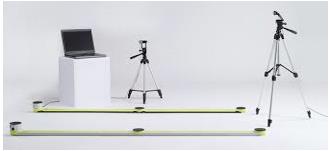
Findings
We aimed for the plyometric training, combined with the other means used in training, to be used in the preparatory and pre-competition period, giving it up 10 days before a competition.
For the final experiment, muscle training programs were composed, through plyometric and psychomotor exercises, for the group involved in the experiment, which worked according to the planning conceived by us, for the development of the components of psychomotor skills. The content of the program was predominantly plyometric, combined with various psychomotor exercises.
In order to avoid possible injuries to the athletes, we performed a thorough warm-up before the start of the training programs and we also made sure that each athlete masters the movement of contact with the ground and the correct position of the body during landing, as well as the technique of performing the exercises. Plyometric. For exercises that involve the high plyometric method, we placed gym benches 30 cm high, and we had in mind that the landing should be done with the knees bent at 600 and 900. Our intentions, by applying these exercises, were to develop the main muscle groups: gluteal muscles, adductors, abductors, semitendinosus, gracilis, biceps femur, semimembranosus, gastrocnemians, solarium, vastus lateralis and medial, right femur, sartorius, gracilis and train them to get a uniform response to their demands which occur during the match, but also to develop the other muscle groups, for the general preparation of the whole body, for effort. Also, in the proposed program, we aimed to make the sequence of the exercises from simple to complex and from easy to difficult, namely from small number to large number and from a smaller load to a larger one. Thus, we took each component or associated 2.3 components and developed a set of exercises for each of the objectives pursued.
The first parameter measured with the OptoJump was the contact time where we recorded an improvement of the average of 0.065 seconds (Table 1). The coefficient of variability (Figure 2) shows an average homogeneity at the initial test while at the final test it reaches a very good homogeneity of performances (TI - 20.553%, TF - 5.974%). By calculating the test "t" we obtained a significant threshold of truthfulness less than 0.01, representative of our study, the value of "t" was 3.532. The value of "t" according to Fischer's table is 3,499.
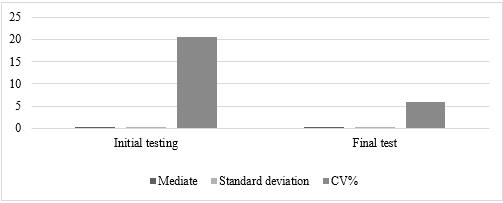
Another measured parameter was the, and as can be seen from Table 1 and Figure 3, at the initial test of this sample, the team subjected to the experiment obtained an average of 0.367 seconds, and at the final test 0.399 seconds. The calculation of the coefficient of variability shows a group with a high degree of homogeneity (TI - 11.989%; TF - 11.779%). The value of "t" was 2,509 (significant p <0.05) and its value according to Fischer's table was 2,365.
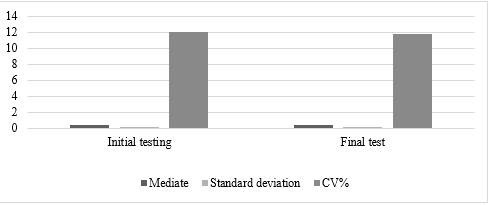
is one of the parameters calculated by applying the tests on the OptoJump measuring platform (Figure 4). This, with the help of this device, the height indicator registered a significant increase in the group under test of 2,789 cm (Table 1). The coefficient of variability shows an average homogeneity in both tests (TI - 24.024%, TF - 23.615). By calculating the "t" test we obtained a significant threshold of veracity of less than 0.05, representative of our study, the value of "t" was 2.448, and its value according to Fischer's table was 2.365.
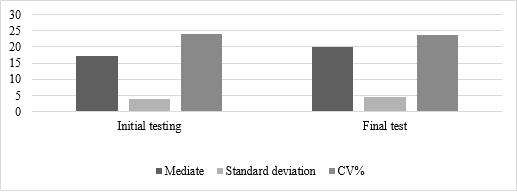
is another parameter that we can measure with the help of the OptoJump device (Figure 5). Regarding the power indicator, the arithmetic mean of the expression group was 21,211 w/kg at the initial test and 27,008 w / kg at the final test, obtaining a progress of 5,797 w / kg. The coefficient of variability shows two groups a low degree of homogeneity (TI - 30.413%, TF - 37.588%).
Continuing to apply the "t" test between the initial and the final test, it indicates the value of 2,448 which shows a significance for a threshold less than 0.05. The value of "t" according to Fischer's table is 2,365.
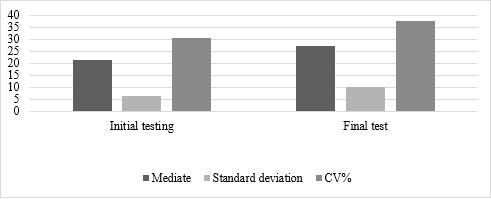
Another parameter measured in our experiment was the rhythm of the jumps (Figure 6). As can be seen from Table 1 in the initial test recorded 1,465 steps / second and in the final test 1,567 steps / second, obtaining a progress of 0.102 steps / second.
The value of “t” for the experiment group is 2,613 (significant p <0.05). Regarding the coefficient of variability, it has values that indicate high homogeneity (TI - 11.740%, TF - 5.998%).

The RSI (resistance index) is the next measured parameter of this test (Figure 7), in which the group under test obtained an average of 0.628 seconds in the initial test and 0.89 seconds in the final test, therefore the progress made was 0.262 seconds (Table 2). Regarding the coefficient of variability, it has a low degree of homogeneity (TI - 44.267%, TF - 52.584%).
Continuing to apply the "t" test between the initial and the final test, it indicates the value of 2,447 which shows a significance for a threshold less than 0.05. The value of "t" according to Fischer's table is 2,365.
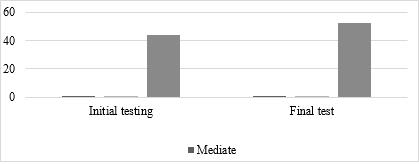
Another parameter measured by this test is the "Jumping Point", which shows us where the center of gravity is when jumping on both legs. Thus, the average at the initial test is -14.232 cm which indicates a displacement to the left, and at the final test the average displacement of the center of gravity is also to the left but reaches only -3.333 (Table 2). The coefficient of variability is insignificant for both tests. Further applying the “t” test between the initial and the final test it indicates the value of 4,612 which shows a significance for a threshold less than 0.005. The value of "t" according to Fischer's table is 4,317.
Conclusions
Physical preparation is the foundation on which the other types of preparation are based and it is the one that can make the difference when the opponents are close in terms of technical value (Cosma et al., 2017).
This training method is very useful in the training of future high-performance tennis players, and its application does not require expensive equipment or specially designed spaces. In summer, workouts can be held on the outdoor tennis court. The exercises used in the preparation of tennis shoes were accessible and motivated the athletes to have a maximum performance during training. In all our athletes in our experiment, there was a significant progress for all motor skills, and especially for the one we aim for, strength. We used accessible and easy-to-apply exercises in the training of tennis players, which gives them motivation to perform them. Physical training plays an extremely important role in the technical and tactical manifestation of tennis players on the field, so it is necessary to pay special attention to it. An important role in expressing sports performance is played by muscle training, it helps to install the sports form and obtain a maximum performance in competitions, to prevent injuries and contributes to a quick recovery after injuries.
The training programs developed by us included exercises with the exact determination of the number of repetitions and sets, depending on the ability of each player to cope with the effort. Because the plyometric method employs complex natural mechanisms, which produce muscular and nervous changes, they improve and facilitate the faster and stronger technical execution of the service. In plyometric movements, the extension of the serial elastic component is present, which, through muscular contraction, produces a potential elastic energy similar to that of a compressed spring. That is why we recommend the plyometric method to be used in the physical training of tennis players.
References
Banciu, N. A., Cosma, G., & Lică, E. (2019). Description, evaluation and analysis of physical tests corresponding to tennis player. Journal of Sport and Kinetic Movement, 34(II), 80-85.
Colomar, J., Corbi, F., & Baiget, E. (2022). Force-Time Curve Variable Outcomes Following a Simulated Tennis Match in Junior Players. Journal of Sports Science and Medicine, 245-252. DOI:
Cosma, G., Barbu, D., Nanu, M. C., Burcea, B., & Cosma, M. A. (2017). Pregătirea fizică în sportul de performanță [Physical training in sports performance]. Universitaria Publisher.
Dobos, K., Novak, D., & Barbaros, P. (2021). Neuromuscular Fitness Is Associated with Success in Sport for Elite Female, but Not Male Tennis Players. International Journal of Environmental Research and Public Health, 18(12), 6512. DOI:
Genevois, C. (2019). The importance of aerobic fitness for tennis: a review. ITF Coaching & Sport Science Review, 27, 20-22.
Giménez-Egido, J. M., Ortega, E., Verdu-Conesa, I., Cejudo, A., & Torres-Luque, G. (2020). Using Smart Sensors to Monitor Physical Activity and Technical-Tactical Actions in Junior Tennis Players. International Journal of Environmental Research and Public Health, 17(3), 1068. DOI:
Kovacs, M. S. (2006). Applied physiology of tennis performance. British Journal of Sports Medicine, 40(5), 381-386. DOI:
Kozina, Z., Yevtyfiieva, I., Muszkieta, R., Krzysztof, P., & Podstawski, R. (2020). General and individual factor structure of complex preparation of young tennis players of 10-12 years. Journal of Physical Education and Sport, 20, 1242-1249.
Lambrich, J., & Muehlbauer, T. (2022). Physical fitness and stroke performance in healthy tennis players with different competition levels: A systematic review and meta-analysis. PLOS ONE, 17(6), e0269516. DOI:
Mahn, P. A., & Gaviao, M. B. (2010). A influencia do treinamento resistido em athletas de tenis de campo [The influence of resistance training in field tennis athletes]. Revista Brasileira de Ciências da Saúde;8(24), 3-7.
Niculescu, I. (2006). Evaluare motrica si somato-functionala [Motor and somato-functional evaluation]. Universitaria Publisher.
Petrakos, G., Morin, J.-B., & Egan, B. (2016). Resisted Sled Sprint Training to Improve Sprint Performance: A Systematic Review. Sports Medicine, 46(3), 381-400. DOI:
Reid, M., & Schneiker, K. (2008). Strength and conditioning in tennis: Current research and practice. Journal of Science and Medicine in Sport, 11(3), 248-256. DOI:
Roşculeţ, I., Ţifrea, C., Vilaça-Alves, A., & Vasiliu, A.-M. (2022). Preliminary Research on Physical Performance in Junior Tennis Players U16. Revista Romaneasca pentru Educatie Multidimensionala, 14(1Sup1), 145-154. DOI:
Turner, M., Russell, A., Turner, K., Beranek, P., Joyce, C., McIntyre, F., & Cruickshank, T. (2022). The association between junior tennis players' physical and cognitive attributes and groundstroke performance. International Journal of Sports Science & Coaching, 174795412211068. DOI:
Copyright information

This work is licensed under a Creative Commons Attribution-NonCommercial-NoDerivatives 4.0 International License.
About this article
Publication Date
10 April 2023
Article Doi
eBook ISBN
978-1-80296-961-0
Publisher
European Publisher
Volume
5
Print ISBN (optional)
-
Edition Number
1st Edition
Pages
1-1463
Subjects
Education sciences, teacher education, curriculum development, educational policies and management
Cite this article as:
Radu, I. A. (2023). Improving the Muscle Strength of The Lower Limbs in Junior Tennis. In E. Soare, & C. Langa (Eds.), Education Facing Contemporary World Issues - EDU WORLD 2022, vol 5. European Proceedings of Educational Sciences (pp. 732-740). European Publisher. https://doi.org/10.15405/epes.23045.73

